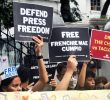A Dual-Book Review
Myfel Joseph D. Paluga
Department of Social Sciences
University of the Philippines Mindanao
Building People’s Power. By Jose Maria Sison. Volume 2 of People’s Struggles Against Oppression and Exploitation. The Netherlands: International Network for Philippine Studies (INPS), 2016. Editor: Julieta de Lima. 474 pp.
Building People Power
Aside from producing for us the same quality of usable ‘spartan formulations’—on sociopolitical terms as classic as ‘class struggle’ and political themes as resurgent as ‘mass movement’ and ‘communist party’, in the national or in the global scene—Prof. Jose Ma. Sison’s second volume, Building People’s Power, can also be used now, more apt than ever, as a way of re-viewing the ‘PNoy Regime’ (2010-2016).
This new set of Sison’s collected writings from 2010 to 2011 (messages, interviews, political statements, remarks to study groups, and other forms) is a way of refracting that period so we see light and learn lessons from it.
The following five vignettes demonstrate the continuing freshness of his perspectives and analysis.
Vignette 1. Do not spend wantonly the populist mystique
With Duterte’s landslide win of the presidency, despite the whole PNoy state machinery backing Roxas, the powerful ‘mystique’ of Aquino/people power/yellow ribbon phenomenon when PNoy ascended into power six years ago is quickly becoming forgettable. And yet, let us spoon a sample soup from the book, and here is Joma on PNoy, 11 August 2010:
‘The Aquino regime is just a passing pro-imperialist regime. It has cashed in on the mystique of his parents and he is wantonly spending it. It is running against itself and will soon be utterly discredited.’ (59)
The present Duterte administration can learn a lot from the Aquino Regime: not to spend wantonly the symbolic capital of the ‘Duterte mystique’.
Vignette 2. Beware of false, non-dialectical newly-minted theories
And what about Joma’s advice then to those in the academia, in those years when postmodernist fad-formulations continue to appear ascendant in the social sciences—with their ‘nuances’ and ‘fluidities’ (or as I remember it critiqued, French-philosophy style, by a mathematical philosopher: with their ‘ramified desire for an atonal world so nuanced that no figure of decision is ever possible and any scene of Two is erased’)? Another sample from 2010, in a solidarity message:
‘Take the stand, viewpoint and method of materialist dialectics and use class analysis to debunk those who misrepresent the latest intellectual spin as new and therefore correct. I have always told faddists among the intellectuals on and off campus and NGO who brag about their new language that all the newly-minted petty bourgeois terms coming from imperialist-directed think tanks and institutional and mass media channels can never make Adam Smith younger than Karl Marx. It is monopoly capitalism and finance monopoly capitalism that is obsolete and moribund.’ (72)
Vignette 3. Build real mass movements (and the people’s government)
But while multilevel crisis were heightening, one can also note that the years 2010 and 2011 are also times of challenges on how to rekindle the decline in youth activism during this period. Joma’s discussions with youth participants in an assembly of the Student Christian Movement (24 September 2010) and his message to a congress of Anakbayan (15 May 2011)—and then also in one solidarity message that turned into a ‘gentle reminder’ on missed points—give one important piece of practical advice often forgotten amidst the grand calls for ‘mass movements’ (the danger is to simply equate ‘mass mob’ to ‘rally’). That piece of advice is: organizers, always bring with you a pamphlet of your organizations’ Constitution and Program, and widely distribute them to those you want to recruit. Here is a portion of Joma’s message to Anakbayan youths in 2011, with intensifying state aggression of PNoy regime in the backdrop:
‘The Aquino regime is carrying out brutal and bloody campaigns of suppression against the progressive forces. Military, police and paramilitary violence is accompanied by pretense at peace negotiations, and military operations are being labeled as peace and development operations. Do your best to attract and enlighten the Filipino youth. Ignite their emotions and raise the level of their consciousness. You should widely circulate the pamphlet of the Constitution and Program of your organization. The understanding and acceptance of the Program and Constitution is enough for an applicant to be a member. Follow it up with courses. Remember that it is meaningful and a big thing for the applicant and for Anakbayan to take the oath and become a member. Do not use the word consolidation to stifle expansion. Expand to have people to consolidate, especially if the number of members is declining.’ (Italics added; 269-271.)
One may wonder why is understanding a ‘program and constitution’, taking ‘oath’ and ‘becoming a member’ of a political organization given formal importance? Because ‘mass movement’ is really about training people in the science of governance: on building the people’s government on scientific and rational foundations. While this may be missed in the hectic day-to-day life of full-time organizers, Sison’s emphasis of it here sharply reminds us that we are preparing for the full realization of the people’s revolution and the establishment of a people’s state, or even of a ‘coalition government’.
Vignette 4. Raise high the quality of theoretical jousts (A ‘natdem history’ of UP)
How was the more solid ‘people’s power’ of the ‘national democratic movement’ built, such that it continued to pose formidable challenges to all puppet regimes all the way to PNoy? Varied historical essays can also be found in the book, based on Joma’s personal recollections (like his interactions with Ninoy Aquino). One historical gem of this flow that any UP student should read is the essay entitled ‘Foundation of the ND Movement in UP’, which is also singular in being the only article in the volume that is co-authored with Julieta de Lima. Joma recalls the UP Diliman activists of the late 50s, eager to ‘test their knowledge of dialectical materialism with a dean who was a logical positivist’ and trying to ‘seek consensus on current issues with students and faculty members’, including one who could ‘skillfully render Marxist ideas in liberal language’ (36). (One might also imagine then a 21st century scholar, who can skillfully render Marxist ideas in either postmodernese, or why not, in Manobo epic language. To imagine a revolutionary who, as in the early Christians, knows how to ‘speak in tongues’ so as to convert more ‘foreign’ souls.)
This has taken on a greater significance with the neoliberal encroachment in the national university under the helm of PNoy-appointed UP President Alfredo Pascual. While initially supported by progressives, Pascual has shown where his true persuasions lie with intensifying commercialization of education, and, more worryingly, the erosion of the liberal and philosophical ideals of university education. This is a timely call to revive principled theoretical jousts in the tradition of the 50s-70s.
Vignette 5. Do not delink the ‘peace process’ from ‘armed struggle’ and vice versa
Variously scattered in the forms of statements, messages and media interviews in 2010 and 2011 are writings of Joma that reflect how creatively the national democratic movement tried to deal with a regime that was remiss in accepting the rigors of real ‘peace negotiations’. The PNoy regime has by its acts practically reduced the peace process to mere talks about ‘ceasefire’ and ‘laying down of arms’, coupling it with the usually-heard thinking that ‘the NDF is not really serious’ and would just ‘use the peace process as cover’ for what they really are ‘fixated’ about, which is the ‘armed struggle’.
This non-understanding of ‘armed struggle’ (and its relation to other modes of struggle, political negotiations included) in the fullest sense, which is not just about the use of the guns and weapons, can now be seen—given the possibility, and stark contrast, that the Duterte administration opened—as poor political imagination of the faded regime.
Brief digression to past writings of JMS. As formulated by the ND movement from its inception, ‘armed struggle’ is part of the discourse on ‘people’s war’ and the ‘national democratic revolution’. One of Joma’s earliest formulation of the concepts ‘people’s war’ and ‘armed struggle’ can be found in the “Declaration of the New People’s Army” in 29 March 1969 (in Selected Writings 1968-1972: Foundations for Resuming the Philippine Revolution: pages 95-118, especially in the section, ‘main tasks of the New People’s Army’). In the course of the unfolding history of the people’s struggles, the phrase ‘armed struggle’ became a kind of synecdoche for the broader concept, ‘people’s war’ and ‘revolution’—understandably so, because it came to be mostly contrasted, during EDs and debates, to some middle-class’ spontaneous gravitation towards ‘parliamentary struggle’ and spontaneous aversion to ‘guns’ and ‘violence’ (but curiously not to state violence and its guns). In popular discussions, ND militants loyal to Joma’s formulations would assert that ‘a true revolutionary is always for the armed struggle’.
So what is really this fearsome term ‘armed struggle’?
‘I have three sisters: Juana, Eva, and myself’ or how to conceptualize properly ‘armed struggle’. The much-discussed category ‘armed struggle’ (or the ‘people’s war’) is a wrap-around term encompassing three elements: ‘agrarian revolution’, ‘base building’, and—like the logical set that ‘contains itself as its own element’—‘armed struggle’ itself. So here, even if one is just an attentive listener of the ND discourse, one hears a more complex point about the concept of ‘armed struggle’ in the national democratic movement: that its construal and formulation itself is indicative of an open, self-conscious agency and not the mindless violence of a robotic category. That conscious, self-referential structure of ‘armed struggle’ is what cuts for authenticity and provides openness among revolutionaries for novel proposals if the other party—the ruling regime—is true.
This looping formulation highlights the assertion that the very idea of ‘armed struggle’ is deeply entwined/twirled with its other sister-components, comprehensive agrarian reform (aka, ‘agrarian revolution’) and all-round sociopolitical strengthening starting from the countryside (aka, ‘base building’).
Back to the PNoy period: PNoy mistook the gun for ‘armed struggle’ and so failed to grasp the authenticity of NDFP’s ‘peace proposals’ As shown by the 2010-2011 writings of Joma, as political consultant of the NDFP in the peace negotiation, the ND movement creatively tried to remain true to the formulations of prior signed agreements while maximizing rooms for creativity in the highly constrained political atmosphere of the PNoy regime. This is indicated by its novel proposals for ‘immediate truce and alliance’ on the basis of ‘mutually acceptable declaration of principles’ that is, in the ND language, more bourgeois rights yet than socialist in the proper sense.
But from 27 July 2010 statement (‘Two Proposals’) to 14 November 2011 presentation (‘Remedies to obstacles’), with many other relevant reaching-out and reasoned statements in those two years, one only reads a continuing neglect of the offered proposal for peace by the PNoy Regime.
Observations and works in the international scene
More than half of the book’s selected writings, however, are on the global scene: Joma’s interesting interventions and analysis of the events later called the ‘Arab Spring’ (Tunisia, Egypt, Libya, and others in the Arab League), his statements as ILPS Chairperson (International League of Peoples’ Struggle) on Julian Assange and Wikileaks, on the 10th anniversary of 9/11, and many others. I will not anymore quote resplendent lines from these set of articles to allow readers to discover those pearls themselves.
Enjoy (and remain true to) the formulas
I invite readers to simply enjoy this second volume of Prof. Joma, those humble but militant readers who are not addicted to the academic trappings of university press books but who simply want to be refreshed by timeless revolutionary formulations embedded in concrete situations and tasks.
For ND old-timers—knowing and living well their varied tasks, all-too-familiar with the substance of Joma’s works—read this book (and all his other collected writings) for the solid glints of these writings as writings, or in Don Pagusara’s felicitous phrase, ‘Joma’s scriptures’. So enjoy the surface scripts.
For newcomers to Joma’s scriptures, especially the web/digital-savvy youths of today: don’t be deceived by the book’s unassuming, graphic-less appearance: read without rushing and discover again the art of writing/conceptualizing clearly formulated political lines, as applied to varying national and global contexts.





![[ANALYSIS] A different drug war](https://davaotoday.com/wp-content/uploads/2024/09/1000019103-110x100.png)




